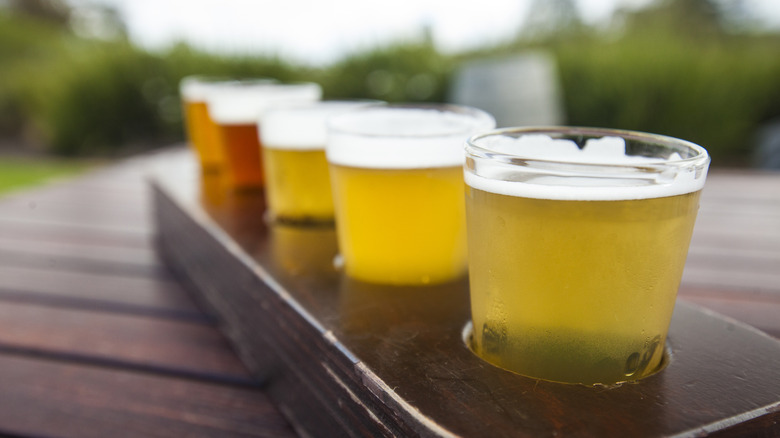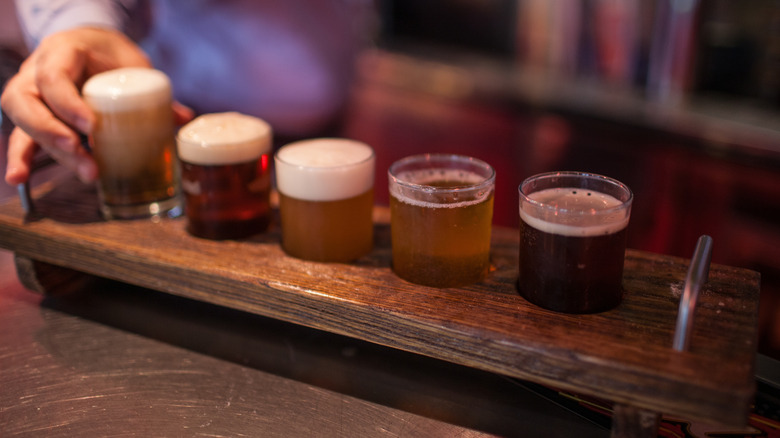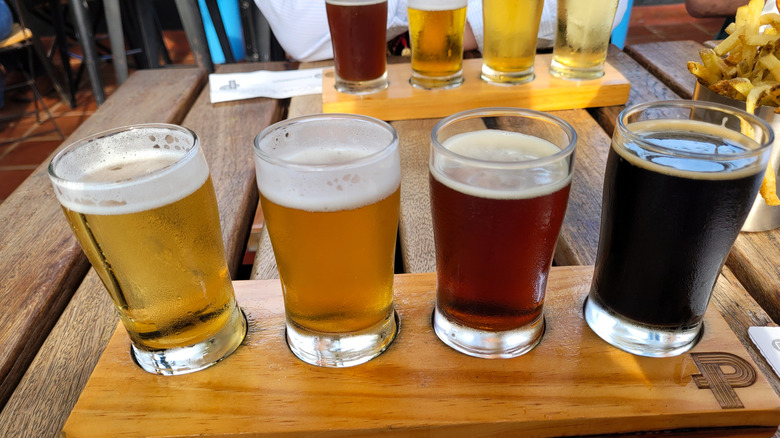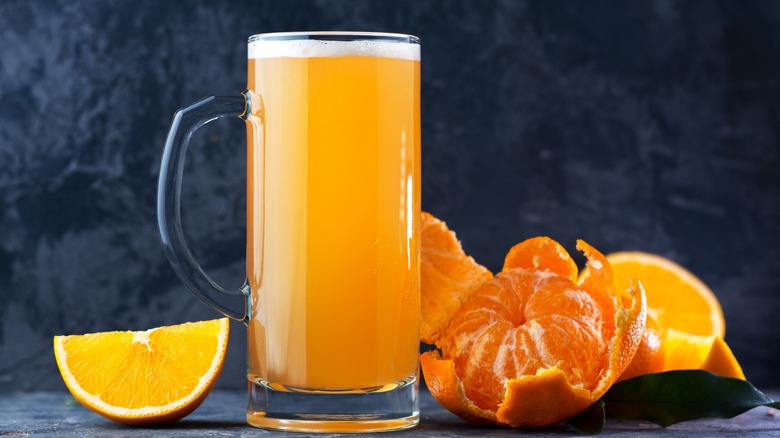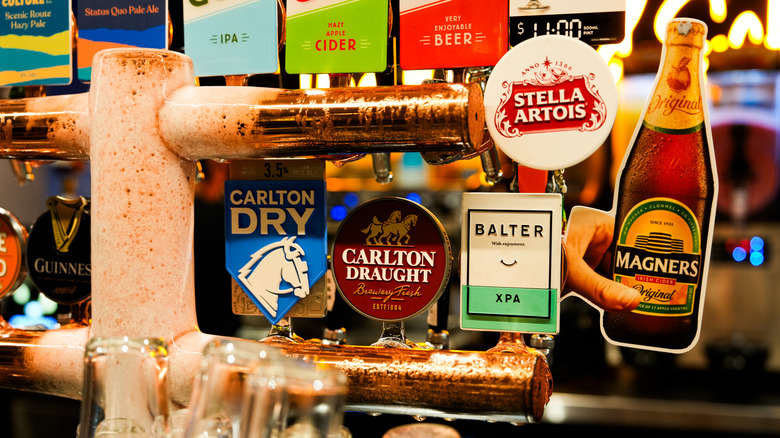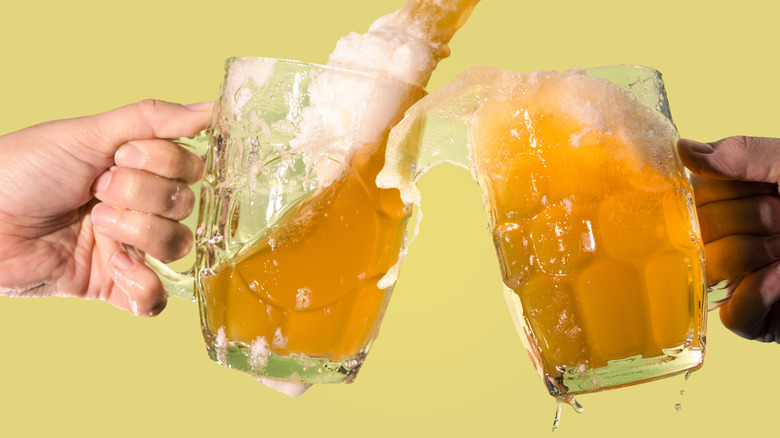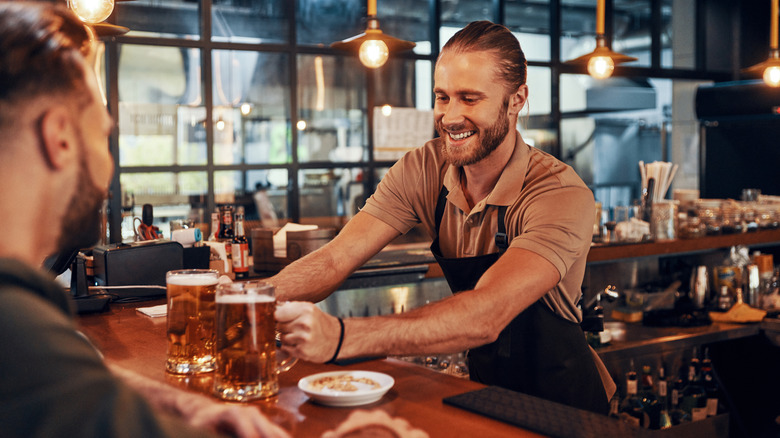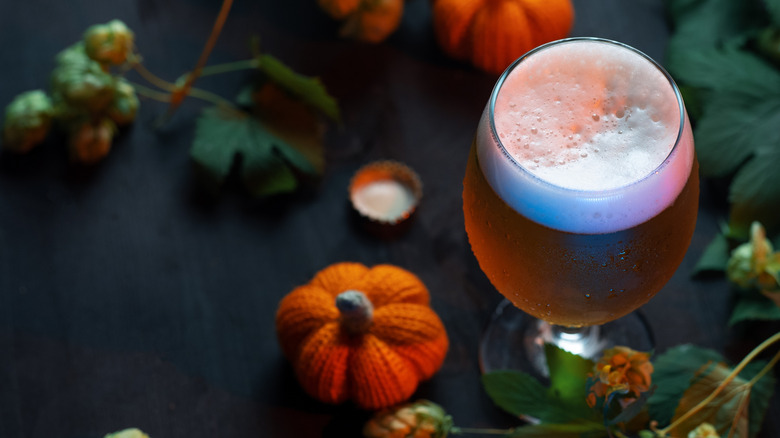How To Put Together The Ultimate Beer Flight
Patio season is upon us. With warmer weather coming our way, it's time to gather the crew for a few brews. Maybe it's also time to mix it up and try something new. If your region is full of local breweries and taprooms, you may have the option to order a beer flight. That's right, tasting flights are not just for wine or whiskey. In the age of the craft brewery, beer flights offer drinkers the opportunity to taste several different brews. It's a great way to expand your palate or find a new favorite. If there's something you're curious about, you don't need to commit to a full pint. Order a flight and see where your fancy takes you.
Many bars and breweries offer customers the chance to select their own tasting, and if you find yourself in such an establishment you might wonder if there's any art to arranging the ultimate beer flight. The answer is yes. We spoke to several experts on the matter, from Beverage Directors, to Brewmasters and Cicerones (which is like a sommelier for beer), and they walked us through the top considerations when constructing a great flight. If you're lucky enough to visit an establishment with an experienced hand behind the bar, they can guide you to your ultimate selection. So next time you hit up a brewery, you can order one big pitcher or expand your palette with a tasting flight.
Four to six beers per flight, four to six ounces per beer
There's no need to get hung up on which type of beer glass to use when it comes to a flight, you'll likely be served identical small glasses filled with different beers. But how many? And how large? Four to six beers per flight, four to six ounces per beer. Experts agree, this is the ideal number of brews for a flight. Three beers is simply not enough variety, and any more than six will overwhelm the palette. You want the drinker to actually experience and remember each taste, to help them decide which beer they'd like to order for their next full glass.
So, now that you've got a number in mind, how much of each beer should you pour? You don't want to give away too much, but you don't want to be so stingy they can't get a good sense of the beer. "The sweet spot in my opinion, is four 4 oz beers," says Katherine Benecke, certified Cicerone and General Manager at New York City's Treadwell Park Beer Hall. "It adds up to a single pint," she explains, "and shows enough diversity while still keeping things digestible for one person and allows for more mindful tasting without fatigue." While you've got a lot more variety in front of you, you're still only drinking the equivalent of one standard pint glass. That way you can move on to your next beer without wondering if you've gone overboard.
Start with a simple question
J Warren Wilson III is the Brewmaster and Chief of Brewing Operations at Readington Brewery & Hop Farm. He's also a BJCP Certified Beer Judge and Level 1 Cicerone. Needless to say, he's thoughtful about building his flights, and says he always likes to start with a question. "Since beer is subjective," Wilson says, "asking someone their preferences will lead you to creating their ultimate flight." He'll start by simply asking customers what they like to drink, and find clues in their answer to building a great flight that will satisfy their taste. From there, "whether you want to go for a large gamut of flavor, or more acutely, dive deep into a style that is left up to the customer to decide." Just ask!
What if the customer really has no defined taste to begin with? Well, if you find yourself or your guests curious about beer without much prior knowledge or preference, Wilson says it's best to show them a range. That way they're more likely to find something they like and start to hone in on their personal taste. "I would offer a progression that introduces a range of flavors, textures, and aromas while still being approachable," says Wilson. "Start by including at least one beer that's widely appealing — something crisp and clean," he says. That way you aren't turning them off right off the jump with a really strong flavor. "From there, gradually introduce more complex or less familiar styles," he says "such as a hoppy IPA, a sour ale, or a roasty stout." This way they likely won't like everything, but they'll figure out where to direct their next sampling.
Arrange beers from light to heavy, from crisp to bold
Once you've selected the beers for your flight, the next question is how to arrange them. Here too we find there's a bit of an art to it. "We always recommend arranging the beers from lightest to heaviest in body," says Chris Ryan, Beverage Director at Sheraton San Diego Resort. Building up from light to heavy makes sense. Once the drinker has a heavier beer on the tongue, it can be hard to go backwards and fully appreciate the taste of a lighter beer.
Certified Cicerone Katherine Benecke considers a few factors when arranging her flights. "A smart flight moves from light to dark in color," she says, "crisp to bold in flavor, and leaves you knowing exactly which beer deserves a full pour." She's working with a progression. A gradual shift from pale to deeper colored beers can be satisfying to look at as well as to drink. Likewise building up to stronger flavors makes for a natural progression for drinkers.
Brewmaster J. Warren Wilson III says flights can also be built by style of beer, by season, or by flavor profile. And he personally tries to vary the flavor profiles of his selections as he moves through the flight from "light to dark, malty to hoppy, sweet to bitter—so the experience stays dynamic and engaging." It can keep the drinker more engaged when they are a little surprised by their next sip.
Group fruited brews together
If you've got some fruitier brews in the mix, it's important to think about how to incorporate them into a flight. "Radlers, sours, and goses tend to be bright, fruited, and acidic," explains Katherine Benecke. She says these flavors can easily dominate the palate, which can make them tough to pair with other beers. "Grouping them together usually works best," advises Benecke, "letting you lean fully into those sharp, refreshing profiles without overwhelming more delicate styles later on."
If you know you enjoy a radler, sour, or gose and you find yourself somewhere with several on tap, consider making yourself a fanciful flight out of these. Sours and goses are not the same thing, neither are radlers and shandys. There's a lot of variety in this area, from refreshing citrusy radlers to sour salty goses. You can easily build a whole flight. If you'd like to include one as part of a wider selection of more traditional styles, Benecke says that's absolutely doable. Her advice is to put it early in the flight, "almost like a palate primer before moving into more malt-driven or hop-forward beers."
Keep ABV in mind
When selecting your flight, Chris Ryan says it's not a bad idea to keep the ABV of the beers in mind. ABV stands for alcohol by volume, and beers can vary greatly from as low as 2% ABV to over 10% (and in rare cases even more). We tend to drink beer in larger volumes than liquor precisely because beers tend to have lower ABV. But sometimes that's not the case, so it's worth checking the label to make sure you know how alcoholic your brew is. The world's highest ABV beers even come with a warning label.
"Avoid having too many high ABV beers on the same flight," Ryan advises, "as that can sometimes overpower the pallet." Now, strong flavor and high alcohol content are not necessarily the same thing. You can find a dark brew with low ABV. All types and colors of beer can be made with higher or lower ABV.
Go for depth or breadth
Katherine Benecke says craft bars use flights as a tool to either "show off the full range of styles on tap or to highlight the diversity within a single style." So, you can arrange a great variety of beers on one flight, or you can hone in on a specific style of beer and demonstrate the great range within that style. "If you're building with contrast," Benecke says, "keep an eye on balance: alternate high-impact beers with something lighter or palate-cleansing to reset and re-engage the taste buds."
If you know you love dark beers, or you're curious to learn more about what stout beer is versus the distinctions of porter, there's a whole world to discover just in this range. Benecke says she likes starting with something "lighter-bodied and roasty, and moving toward heavier, sweeter, or barrel-aged styles." Not all stouts are created equal. There's a tremendous variety of textures, flavors, and ABV. Beneckie would start with a dry Irish stout, then pour a porter, then a creamier milk or oatmeal stout, and finish things off with "a big, decadent imperial stout." Four pours, four varieties of dark beer.
If IPAs are the name of the game, Benecke says the goal is to provide a tour, "starting with a clean, crisp, bitter West Coast IPA, then moving into a West Coast–East Coast hybrid." She'll keep moving east with "a hazy New England IPA that leans lush, juicy, and tropical," she says, "and finish with a big, resinous double or triple IPA." Who knew there were so many wonderful adjectives to describe one type of beer?
Minimize major flavor clashes
Katherine Benecke says some styles of beer can "clash and overwhelm each other." When arranging the ultimate flight, she tries to avoid putting more aggressively flavored beers right next to each other. "You want a logical flavor progression," says Benecke, "not palate confusion." She asks us to "think of a flight like a story." It wouldn't make any sense to tell it out of order.
But again, that doesn't mean there can't be variety in your flight. "You can build a flight of wildly different beers that somehow complement each other," Benecke reassures. "Contrast can be exciting," she says, "but it takes a little finesse." Just be purposeful about your pairings. Consider the order of these stronger flavors, how they sit on the palate, and how they inform one another.
Build on customers' tastes and preferences
Maybe you're working at a taproom, maybe you're visiting one, or maybe you're just browsing craft brews at a liquor store dreaming up a fun flight tasting activity for your next backyard barbecue. In any case, the goal is to strike a balance between giving the people what they want, and offering them something new to try. "We try our best to tailor flights to our guests' preferences," says Chris Ryan, "but also love when they are willing to step out of their comfort zone."
Katherine Benecke advises that the best way to challenge someone's palate is to "build from what you know: starting in the wheelhouse of beers you already like to drink and slowly graduating in flavor and intensity." Meet the drinker where they're at, and then introduce a slightly bolder variation in the second half of the flight. That way you ease them in and earn their trust.
But Benecke goes on to say, "the best flights don't just stick to familiar territory." Including one beer in the flight that's just outside the drinker's typical preference without completely veering into left field can be the thing that makes a good flight great, she says. "It's often the unexpected pour that ends up being the favorite!" J. Warren Wilson II agrees, "including at least one beer that pushes the boundaries of what the guest might normally choose encourages discovery without overwhelming them."
Add some seasonal flair to your flight
If you're visiting a brewery, it's likely they will have some exciting rotating taps. If you get to build your own flight, consider adding something seasonal to the mix, and enjoy it while it lasts! J Warren Wilson III of PLACE confirms that beer flights tend to vary seasonally. "Breweries typically rotate their selections to reflect the flavors and styles associated with different times of year," he explains. This is a great way to encourage repeat customers, as they know they'll discover something new in every season that complements the weather, ingredients of the moment, and corresponding holiday flavors.
Wilson says that spring and summer flights tend to feature "lighter, refreshing styles such as pilsners, wheat beers, session IPAs, and fruit-infused ales." When we get into fall you'll start to find Märzens, Oktoberfest lagers, and of course pumpkin ales. In winter, a flight will likely highlight those darker and richer beers from stouts and porters to seasonal spiced ales. There's always more to discover.
